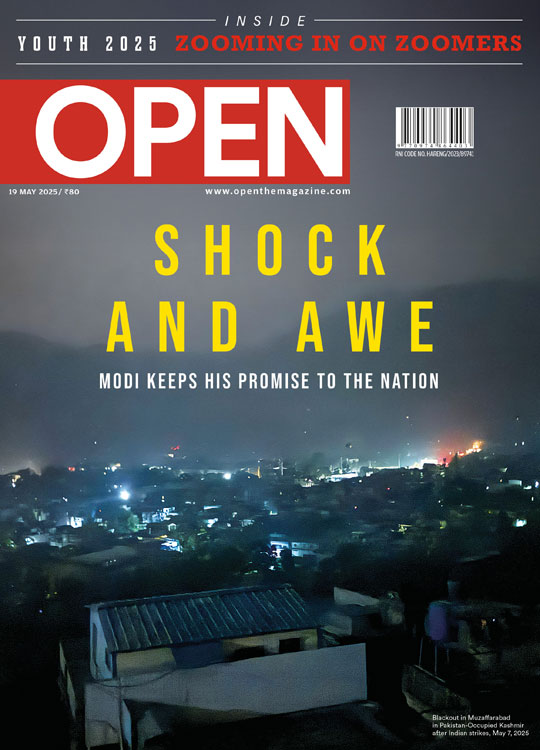Fear and Loathing in Aligarh
Assertions of religious identity in the face of sectarian politics put the spotlight on India’s most famous Muslim university
/wp-content/uploads/2018/05/Aligarh1_0.jpg)
IN THE SCORCHING afternoon of May 7th, speakers at what students of Aligarh Muslim University (AMU) now call the ‘protest site’ close to Baab-e-Syed, the imposing gateway to its 450-acre campus, hold a crowd rapt with couplets, snappy one-liners and fiery protest speeches. The punishing sun does nothing to deter the eloquence and humour of these young men and women. One student blasts what he calls ‘an unholy nexus of Hindutva elements’ and a section of the city police. Like many speakers before him, he sees a conspiracy in the transfer of the senior superintendent of police in the region a day before the visit of former Vice-President Hamid Ansari to AMU.
According to most AMU students I spoke to, pistol-wielding youth allegedly affiliated to the Hindu Yuva Vahni, a militia of sorts founded by Uttar Pradesh Chief Minister Yogi Adityanath, tried to barge into the campus—with the alleged connivance of the police, a charge they deny—minutes after Ansari arrived. The preceding speakers at the gathering have outlined the events of May 2nd thus: as soon as Ansari’s car entered the campus at 10 minutes to 3 pm, bike-bound miscreants brandishing country-made revolvers and lathis, along with policemen, came in through Baab-e-Syed. They beat up the security guards and some students before they were overpowered by the arrival of a larger group of boys, and handed over to the police. Calm would have prevailed by 3.30 pm, say students, but then they found that the six people turned over had been released by the cops without an FIR being filed and their protest was met by a lathi charge and tear-gas shells hurled at them by the police. The police version is that the situation was about to turn violent and they had to act in self-defence.
Speaker after speaker pokes fun at this police ‘theory’, narrating a blow-by-blow account of what happened and offering details of who was injured and how badly they were hurt in the lathi charge. They also recount the slogans raised by the intruders: ‘AMU ke gaddaaron ko, goli maaro saalon ko (AMU’s traitors, shoot them)’, among them.
The speeches receive loud applause. Jinnah, most speakers say, does not inspire them at all. His portrait just happens to be there in the AMU Students Union office, just as one exists in the Permanent Judicial Museum at the Bombay High Court that was inaugurated by Prime Minister Narendra Modi on February 14th, 2015; another in an institute in Shimla; at Sabarmati Ashram; and a few other places in the country. A history student, Zarfaraz, whispers into my ear that he has never looked up to Jinnah, sees him only as a historical figure, and that his portrait is there only because he was offered life membership of the Union back in 1938. “He is only a museum piece here,” he says, “There are, of course, some people who may respect him as a lawyer and so on because he had represented the likes of Bal Gangadhar Tilak and Bhagat Singh in court, but then such opinions are par for the course in a democracy like India.”
“Attacks on educational institutions by communal forces need to be called out for their ulterior motives” Oroosa Anwar, BA Honours student of English
Meanwhile, another student speaker addresses Hindu nationalists with a rhetorical barb: “Elections are around the corner in some places in the country. So, for you, it is important to rake up such non-issues. As far as we are concerned, Jinnah ka djinn India se bahut pehle jaa chuka hai (for us, the demon of Jinnah left India long ago).”
This mood of defiance, like the arguments being made, are at variance with perceptions of the university across India, a result perhaps of media coverage. Originally set up by Sir Syed Ahmad Khan as Mohammedan Anglo-Oriental College in 1875 and made into a university in 1920, it now offers over 300 courses to more than 30,000 students—including those of affiliated schools, junior colleges and specialised centres of education such as medical institutes and engineering departments—in Aligarh and elsewhere. AMU has always been well regarded as an institution. Yet, suggestions have been aired that the campus has become a haven for ‘anti-nationals’ and a kind of Muslim ghetto. The names of its buildings, its campus mosque, forms of student attire and other Islamic symbols appear to have made the institution a soft target for sundry critics across India.
Students agree that the University should be more cosmopolitan but add that it’s one of India’s few magnets for Muslim students, especially the non-well-off
Irfan Habib, Professor emeritus of history at AMU, has a lot to say about the student agitation, Jinnah, and how the attack on AMU differs from rightist efforts to run down others such as Jawaharlal Nehru University, Tata Institute of Social Sciences, Hyderabad University, Allahabad University and others. “In JNU, the issue was ideological because the university is seen as a stronghold of the Leftists. Here, the issue is communal,” he offers, “The ruling party in the state and the Centre naturally wanted to rake up the issue after the Kathua incident and ahead of the Karnataka polls. It is also political.” He worries about the campus protestors, though: “They are playing into the hands of the BJP. The issue has dried up and now they must go for talks and thrash out a solution and focus on their exams. This attitude is counter-productive, I think.”
Exams may need to be postponed, with the Students Union not heeding Vice-Chancellor Tariq Mansoor’s call to end the strike and let the law take its course.
Professor Habib is also anxious about the falling number of non- Muslim students in his and other departments of the humanities. When he was an AMU student in the 40s and 50s, non-Muslim students of history were over 35 per cent of the total, a proportion in steady decline. He is also unhappy about so many non-Muslim students opting to stay off-campus, though it’s a mostly residential institution. “The administration should have taken adequate steps to address this issue,” he says, implying that the AMU brass has failed to ensure diversity as a bulwark against Muslim domination.
Students outside the Union building, which houses Jinnah’s portrait and is closed ‘for repairs’, say that Professor Habib speaks from a pedestal of idealism. They agree that AMU should be more cosmopolitan, but add that it’s one of India’s few magnets for Muslim students, especially the non-well-off. A student of English whose surname is Qureshi and who comes from a lower-caste Muslim family of Varanasi’s Madanpura, says there are myriad reasons why he chose AMU over Banaras Hindu University (BHU) in his hometown. Those who argue against AMU’s Syed Hall Mosque, he contends, are tightlipped about a temple and Hindu motifs on the BHU campus. He feels more at home at AMU, while he would have an “eerie sense of insecurity” at the Brahmin-dominated BHU, both as a Muslim and because of his anxiety over having to compete with “very bright” Hindu students of privileged backgrounds.
“In JNU, the issue was ideological because the University is seen as a stronghold of the Leftists. Here, the issue is communal” Irfan Habib, professor emeritus of History
Indeed, AMU was conceived to address the educational backwardness of Muslims and promote Western education in India. Struck by the 1842 replacement of Persian by English as India’s language for governance and judicial proceedings, Sir Syed foresaw a need among Muslims to learn English and study Western sciences so they would not get marginalised. This conviction was strengthened by the aftermath of the 1857 Uprising, and he was helped by Hindu and Sikh royals among others in his modernist educational aims.
Professor Abdul Waheed of AMU’s Department of Sociology was a student here from 1977 to 1981, and has been on the faculty since 1989. As a sociologist, he has studied the university’s evolving role in imparting education with data drawn from surveys on the caste and religion composition of its student rolls. The pre-1947 phase, he says, differs from the post-Independence one. Earlier, most students were elite Muslims and rich Hindus. Poor Muslims back then rarely took to higher education; and almost a third of Aligarh’s Hindu population was either Brahmin or of a mercantile caste, as the academic Paul Brass observers in Ethnicity and Nationalism: Theory and Comparison. The Aligarh region today is around 60 per cent Hindu, and the rest Muslim. “But there is something peculiar about this population: more than half of the Hindus in Aligarh are still upper-caste,” says Professor Waheed, referring to the fact that upper-castes are typically a minority in other Hindu-dominated parts of India.
The trend of Muslims from across north India opting to study at AMU started only in the mid-1960s, says this sociology professor. Until then, he says, Muslims of UP and Bihar attended universities closer to their homes. The main reason, in his analysis, was the surfacing of communal tensions in that period in north and western India after a “peaceful” 1950s in the wake of Mahatma Gandhi’s assassination. Aspiring Muslims of lower social strata also began to stream in. He says the higher representation of Muslims among students and teachers at AMU has got to do with myriad factors. “It is not because the administration has been sleeping over it,” he argues, stating that as a Central university with ‘minority’ status, AMU doesn’t need to fill quotas for Scheduled Castes and Tribes and Other Backward Classes except under the vice-chancellor’s discretion in select courses. AMU’s quota system is different: half its seats are reserved for internal students, those who have been to schools affiliated to the university or attended its undergraduate programmes. A student with, say, a Bachelor’s degree from AMU can apply for a reserved Master’s seat. All aspirants, internal or external, whether from within India or overseas (Palestinians and Iranians tend to apply in large numbers), have to take a competitive test for admission. Upper-caste Hindus of Aligarh are big beneficiaries of this system, says Professor Waheed, because most of them attend AMU- affiliated schools and qualify for its quota, whereas they’d have to get a merit seat at another university which has quotas only for SCs, STs and OBCs.
“Contrary to perceptions, Muslims from outside Aligarh get no special consideration for admission at AMU” – Abdul Waheed, professor, Department of Sociology
As of now, around 30 per cent of AMU’s students are non-Muslim, and contrary to perceptions, Muslims from outside Aligarh get no special consideration for admission. “So, if AMU loses its minority status, it is the upper-caste Hindus of Aligarh who will suffer the most. I tell this to my Brahmin friends here very often, and they promptly agree,” says Professor Waheed, laughing.
How come non-Muslims don’t make up half the total, though? This is a pertinent question, say students and professors. The answer lies in the fact that most Hindu students prefer ‘premium’ courses such as physics, engineering, business management and medicine over the humanities. Besides, there are several courses such as Islamic theology, Arabic and Islam-related subjects that are of negligible interest to Hindu candidates. So Hindus, who have close to 60 per cent of the seats for specialised courses, constitute a lower proportion overall.
NOTWITHSTANDING THE EDGE that upper-caste Hindus enjoy at AMU, the preponderance of Muslim students here has drawn insinuations from some quarters that the university culture fosters Islamic radicalism. This charge has been shrill ever since the now-banned Islamist group Students Islamic Movement of India (SIMI) was created in Aligarh in the late 1970s. Professor Habib says SIMI was funded by Wahhabi money. “Until they started taking the terrorist route, Jamaat-e-Islami and the Government allowed them to flourish,” he says, “But not afterwards. After their ban in the noughties, no such trend resurfaced.”
The general secretary of the AMU employees union agrees. “Frankly, except for that short spell, there has hardly been any radicalisation among Muslim students on the campus,” says Shamim Akhtar, also known as ‘Comrade Shamim’.
“The agitation has been an eye-opener for me, considering the virulence with which some have tried to tarnish the image of AMU” – Fizza Husain, a PhD student and activist
And yet the vague sense of alienation persists among non- Muslims here. Several Hindu students Open spoke to say they prefer not to reside on the campus. “There are a lot of non-Muslims in hostels, but hostel rooms are scarce. As first-year undergrads, we are forced to share rooms with 10 others who have similar food habits and rituals, instead of the stipulated three persons in a room. So we find it more comfortable to stay outside,” says a student from Lucknow.
Sudhir KG Pillai, an assistant professor at Central University of Tamil Nadu who was a student at AMU from 1989 to 1991, says that though Hindus on campus were not in danger, the overt displays of Muslim identity around could be overbearing at times. “We never stepped out of our classes or rooms when there were India-Pakistan cricket matches,” he recalls. “AMU back then was also a recruitment ground for Muslim political leaders in UP and everyone had to get used to their swagger and bunch of handlers.” Proud to be an alumnus of such a fine institution, he says that anti-Muslim voices in public spaces outside AMU contributed to the atmospherics, given the religious divisions in the air during the Ram Janmabhoomi movement.
“The media is missing out on key aspects. Nobody is glorifying Jinnah. We are here to protest the unprovoked attack of students” Afreen Fatima, BA student of Linguistics
Aligarh city has had a history of Hindu-Muslim clashes, but lately, more than riots, communal politics has surged in the area. Professor Waheed feels that it is a new phenomenon associated with the rise of Islamophobia worldwide and in India since 2014. “Things have taken a turn for the worse after the BJP won the polls in UP in 2016,” says another AMU professor. Academics such as Sudhir Panwar of Lucknow University had flagged this trend years earlier, and many students agree with the assessment.
It is in this context that any attack on an institution that has a heavy Muslim presence is seen as an attack on the entire community, even on Islam, which tends to fan their insecurities and make them adhere even closer to their religious and social identity. “That is a trap and an opportunity to hang a bad name on Muslim-dominated institutions,” cautions Professor Habib.
Notably, AMU students have the sympathy of those of other universities that have come under attack ever since the BJP came to power in 2014: from JNU and TISS to Allahabad University and others. In the words of a Dalit speaker at Baab-e-Syed, “You Muslims have been treated as unequal since Partition and we express solidarity with you because we have been treated so since time immemorial.”As this student leader winds up his speech, I speak to another, Fizza Husain, a PhD student and a member of Qafila, a feminist group which has been waging an agitation for more freedom for women on the campus. Though female students at AMU, at 30 per cent, are below the national average of 43 per cent, their numbers have risen over the past few decades. One of the explanations for the high ratio of Muslims here is that conservative Muslim families are more comfortable having their girls study at AMU than at other colleges. Husain says that the Baab-e-Syed agitation has been an eye-opener for her, considering the ‘virulence’ with which some forces have tried to ‘tarnish’ the image of AMU. She has been at the forefront of a fight for women’s rights, getting students to defy rules on leaving campus for ‘outings’, and has earned the anger of both families and the faculty. At present, girl students are allowed out only two evenings a week, an embarrassment for a modern university in a democracy. Husain and her team want unrestricted movement for students regardless of gender.
“Overall, AMU has been a highly secular institution because Leftist forces are very active on the campus” – Shamim Akhtar, general secretary, AMU Employees Union
Another flagbearer of the women’s cause is Naba Nassem, president of AMU’s Women’s College Student Union, who is among those who delivered an impassioned speech after female students broke the locks of their hostel, Abdullah Hall, on the night of May 2nd in solidarity with the male students who were lathi charged.
Husain sees no radicalisation among Muslim students on the campus, saying most of her Hindu friends are equally agitated about the armed intrusion. While people have varied political preferences, she says, it is “lobbies” that call the shots at AMU student elections (barred to political parties). “There are these Bihar, western UP, eastern UP, Kashmiri lobbies,” says she. For women undergraduates, there has been a separate union since 2014.
Afreen Fatima, a second-year BA student of Linguistics who has discarded the hijab, is laconic in her response to the students’ agitation: “The media is missing out on key aspects. This is not about Jinnah. Nobody here is glorifying Jinnah. We are here to protest the unprovoked attack of fellow students.” She says all the regressive measures the university has lately been known for, such as banishing women from the main library for fear of ‘distracting’ male students, are a thing of the past. “Ever since I have joined, I don’t know of any such thing,” says this student from Allahabad.
Oroosa Anwar, a student cabinet member and a BA Honours student of English, rues that AMU has become a target of communal politics. It is a shame on the Centre that the security of a Central university is threatened, says this student from Dharbanga, Bihar. There are some who do not attach much significance to such incidents. TN Satheesan, professor of Malayalam at AMU’s Department of Modern Indian Languages, says the institution has had many ups and downs in the past. “This phase will also pass,” he says. But many others feel that any display of a Muslim identity has begun to draw the heat in a polarised country. “That is a tragedy and a portent of things to come,” says Professor Waheed.
Meanwhile, social media these days is rife with conspiracy theories behind the death of a gay professor, Ramchandra Siras, whose demise in 2010 inspired the Hindi film Aligarh, starring Manoj Bajpai. Online ‘forwards’ allege that he was murdered because he was a Hindu, though the film focuses on his sexual preferences as a reason for his stigmatisation. Other unverifiable tales of Hindus being harassed in Aligarh are also doing the rounds of WhatsApp.
Neem trees dot AMU’s sprawling campus, an academic institution that counts as alumni such notable figures as former President Dr Zakir Hussain, actors Raaj Kumar and Naseeruddin Shah, and freedom fighter Khan Abdul Gaffar Khan (‘Frontier Gandhi’), among others. At the moment, though, the faculty is anxiously watching students erupt in wounded pride and rage.
Also Read
All for the Sake of Nehru
Who’s Afraid of Muhammad Ali Jinnah?

/wp-content/uploads/2025/05/Cover-War-Shock-1.jpg)















More Columns
A Trump Shock To The Pharma World Open
Social Media As an Echo Chamber Nandini Nair
Seventy-two Hours That Changed South Asia VK Shashikumar